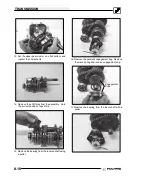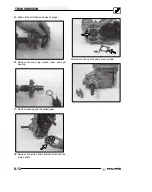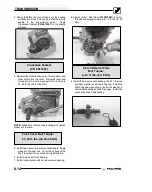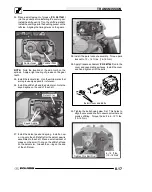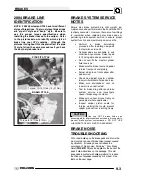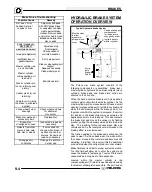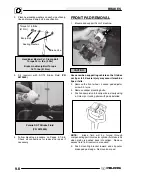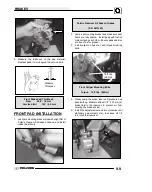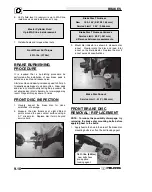
BRAKES
9.5
when the lever is released and the master cylinder
piston is outward. As the temperature within the
hydraulic system changes, this port compensates for
fluid expansion (heated fluid) or contraction (cooled
fluid). During system service, be sure this port is
open. Due to the high temperatures created within the
system during heavy braking, it is very important that
the master cylinder reservoir have adequate space to
allow for fluid expansion.
Never overfill the
reservoir!
Fill to 1/4
″
- 5/16
″
(.64 - .80 cm) from top
of the cylinder.
This system also incorporates a diaphragm (E) as part
of the cover gasket; and a vent port (F) located
between the gasket and the cover. The combination
diaphragm and vent allow for the air above the fluid to
equalize pressure as the fluid expands or contracts.
Make sure the vent is open and allowed to function.
If the reservoir is over filled or the diaphragm vent is
plugged the expanding fluid may build pressure in the
brake system leading to brake failure.
When servicing Polaris ATV brake systems, use only
Polaris DOT 3 Brake Fluid (
PN 2870990
).
WARNING:
Once a bottle is opened, use what is
necessary and discard the rest in accordance with
local laws. Do not store or use a partial bottle of brake
fluid. Brake fluid is hygroscopic, meaning it rapidly
absorbs moisture.
This causes the boiling
temperature of the brake fluid to drop, which can lead
to brake fade and the possible loss of control.
HYDRAULIC
CALIPER BLEEDING
T
his caliper is a single piston design. The caliper
pistons are “T”-shaped, which allows both hand and
foot brake to use the same caliper piston, but remain
separated by seals. The hand brake system applies
hydraulic pressure to both front calipers and only the
outer
diameter of the rear caliper pistons.
The
auxiliary (foot) brake applies pressure to the inner
portion of the rear caliper pistons. Because the hand
and foot brake hydraulic systems are separate, there
are also two bleed screws -- one for the outer fluid
chamber (hand brake), and one for the inner fluid
chamber (foot brake).
The basic procedure for
bleeding the brake system is the same as outlined on
page 9.4 - 9.5, however, each system must be bled
separately.
Hydraulic Auxiliary Brake inspection and adjustment
is outlined in Chapter 2 beginning on Page 2.27.
NOTE:
Uppermost (inner) bleed screw and brake line
(A) is for hand brake system. Lower (outer) bleed screw
and brake line (B) is for auxiliary (foot) brake system.
B
Inner Bleed Screw
Hand Brake
Outer Bleed Screw
Auxiliary Brake
A
B
BRAKE BLEEDING - FLUID
CHANGE
NOTE:
When bleeding the brakes or replacing the
fluid, always start with the caliper farthest from the
master cylinder.
CAUTION:
Always wear safety glasses during these
procedures. Brake fluid will damage finished
surfaces. Do not allow brake fluid to come in
contact with finished surfaces.
NOTE:
Do not remove brake lever when reservoir
fluid level is low.
This procedure should be used to change fluid or
bleed brakes during regular maintenance.
1. Clean reservoir cover thoroughly.
2. Remove screws, cover and diaphragm (C) from
reservoir.
3. Inspect vent slots (A) in cover and remove any
debris or blockage.
B
A
D
C
Sight
Glass
Ill. 1
Summary of Contents for 600 Dragon SP
Page 1: ...2004 SPORTSMAN 600 700 SERVICE MANUAL PN 9918803 ...
Page 138: ...BODY STEERING SUSPENSION 5 16 NOTES ...
Page 210: ...FINAL DRIVE 7 38 NOTES ...
Page 293: ...ELECTRICAL 10 43 WIRING DIAGRAM HAND AND THUMB WARMERS WINCH HUNTER EDITION ...
Page 294: ...ELECTRICAL 10 44 NOTES ...
Page 300: ...ELECTRICAL WIRING DIAGRAM LATE 2004 SPORTSMAN 600 700 MODELS WITH FUEL GAUGE NOTES ...
Page 301: ...ELECTRICAL WIRING DIAGRAM 2004 SPORTSMAN 600 700 HUNTER EDT HAND WARM WINCH ...
Page 308: ...PN 9918803 Printed in USA ...


